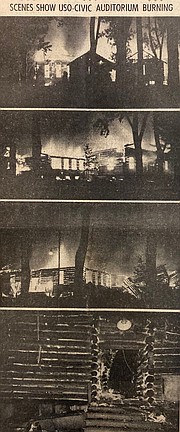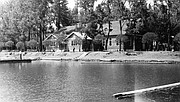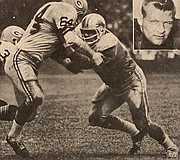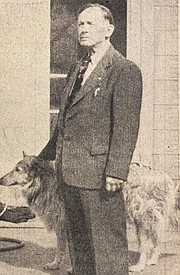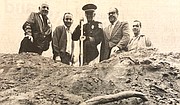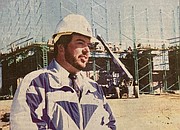HUCKLEBERRIES: The day the swinging and jitterbugging ended
World War II had been over for a month.
But new recruits from Farragut Naval Training Station were still recreating in Coeur d’Alene to enjoy the waterfront and entertainment at the massive USO-civic auditorium at City Park.
Until Oct. 9, 1945.
Shortly before midnight on that Tuesday, 17-year-old sailor William Barna furtively entered a rear door of the log structure and searched jukeboxes for money. Then, he used curtains and paper matches to start a huge fire that would send ashes over a six-block area.
He’d also set fire to three nearby automobiles, tipping off firefighters and police officials that a firebug was on the loose. Flames were shooting 50 to 75 feet in the air by the time the auditorium fire was spotted.
On the following day, the Coeur d’Alene Press described the scene:
“Coeur d’Alene’s civic auditorium, which for the last three years had served as a USO center, was little more than a pile of smoldering ruins today, the result of a fire which broke out shortly before last midnight, and officers today said that they have uncovered sufficient evidence to indicate that the blaze was definitely of incendiary origin.”
Barna, who was described by the Press as “an orphan from New Jersey” and a "sixth-grade dropout," confessed his crimes after 20 minutes of routine questioning by Coeur d’Alene Police five days later. He had joined the Navy on Feb. 1, 1945, and was sent to Farragut only three weeks before the fire.
When asked by police why he set the fire, Barna answered, “I don’t know.”
The loss of the civic center was devastating to the community.
Reputedly the largest log building in the Northwest at the time, the civic center contained 5 miles of peeled fir and tamarack logs. The main auditorium was 136 feet square and able to hold crowds of 1,800 to 2,500 for basketball tournaments, volleyball, concerts, dances and large-group events.
Cost of the WPA (Works Progress Administration) project, according to the Press, “was computed tentatively” at $88,000, with the federal government absorbing 65% of the cost. The commercial value for replacement was set at $150,000.
Construction began March 6, 1936, and finished in 1938.
The auditorium was converted into a USO (United Service Organizations) center when Farragut naval station opened in 1942.
Jim Kershner of The Spokesman-Review once referred to it as “one of the swingin’-est and jitterbuggin’-est spots” in the Inland Northwest. In his blog, Speaking of Idaho, Rick Just wrote, "The Service members could enjoy the beach, weather permitting, and take part in dances, play ping pong, see movies, and just enjoy a little free time. More than 2,000 sailors a day visited the USO during its peak.”
Barna was convicted of second-degree arson and sentenced to five to 10 years in state prison, according to the Museum of North Idaho. He served four years before being released in 1949.
An author, too
On Dec. 31, 1967, Green Bay lineman Jerry Kramer, then 31, made the most famous play of his pro football career.
With 16 seconds remaining in the NFL championship game, Kramer (6 foot 3, 252 pounds) blocked Dallas defensive tackle Jethro Pugh (6 foot 6, 270), allowing future hall-of-fame quarterback Bart Starr to score the winning touchdown. And that decided the famous “Ice Bowl,” a game that began with a temperature of 13 degrees below zero.
Then, Kramer and sportswriter Dick Schapp collaborated on a sports classic about the magical 1967 season: “Instant Replay: The Green Bay Diary of Jerry Kramer.” The locker room view of pro football received instant acclaim, including a gushing article in October 1968 by NEA reporter Aileen Snoddy.
“He is 6-3, 252 pounds of well-dressed masculinity,” she wrote. “He is articulate, has a warm smile and a twinkling ‘all-for-you-baby’ kind of a wink. Jerry gets extra points because he listens attentively, answers even the most-vapid questions with directness and remembers a name after the first introduction.”
Kramer’s book became a multi-million-copy bestseller. Not bad for a former Sandpoint High Bulldog.
Mail bag
A recent Huckleberries column reported on the September 1986 downtown bombings by white supremacists. While gendarmes raced to find out whodunit, then county commissioner Evalyn Adams had duties to perform. Evalyn emails: “We received a phone call at the courthouse that the federal building had been bombed and ‘they’ were headed our way. Frank Henderson was in the office with me that day. We had all the other employees leave the building and then took turns answering the phone. We were the only two people left after about an hour, and fortunately, we were not bombed. I can remember having a feeling about serving in a dangerous situation and could almost envision what our soldiers feel when confronted with enemy fire.”
Huckleberries
• Poet’s Corner: That strange new growth behind her ear/had Mary at a loss;/she went to see the doctor, and/he told her it was moss — The Bard of Sherman Avenue (“Rainy Weather”).
• A.P. Bailey died Oct. 2, 1953, after managing Ohio Match’s extensive western holdings for years. Also, the Lake City man was elected sheriff twice, in 1909 and 1913 – and held office when the county seat moved from Rathdrum to Coeur d’Alene. As a young man, he played for the first Idaho Vandals football team, quitting after two years because he couldn’t afford $3.50 per month for room and board.
• Ground-Breaking: During a brief ceremony 50 years ago (Oct. 17, 1973), Fire Chief Joe Turk tossed the first scoop of dirt as Coeur d’Alene broke ground on a new fire station at Fourth & Foster. The ceremony followed action by the City Council the night before to award a lower, revised contract to Jack Morgan Construction of Dalton Gardens for $110,000.
• Chili Contest Redux: Myra Franks and her Toilet Bowl Chili placed 19th of 100 in the 1993 World Chili Cookoff in Reno, Nev. “We didn’t want to disgrace Idaho,” Myra said afterward. Last month, you learned here that Myra earned the right to compete at the world championships by winning the Idaho Chili Cookoff at State Line. Said she: “Maybe next year, we’ll be in the top five.”
• Nattering Nabobs: In the “No Good Deed Goes Unpunished” Department, Principal John Brumley was happy to see the exterior classroom walls going up at the new Lake City High 30 years ago (fall 1993). That meant school construction was on schedule. And it defused criticism from squawkers who complained that the football field and sports complex were built first.
Parting shot
Occasionally, the late David Bond would break from California bashing to caution his Coeur d’Alene Press readers about … California bashing. There’s a difference between “innocents and butt-hooks” immigrating from California, Dave said in a column in the of fall 1993. The “innocents” brought variety with them. Without the incoming Golden Staters of the '70s, Dave said, “gourmet dining here would still consist of deep-fried prawns, and you’d have to look in the witchcraft section of the local supermarket to find garlic.” By contrast, he said, the “butt-hooks” subdivide or “concertina-wire off the local beaches and called the rest of us rubes for opposing them.” Ex-Californians, as do all newcomers, said Dave, created longer lines and cursed real estate inflation. But they also brought “work, money, culture, grammar and an appreciation for open spaces we often take for granted.” Besides, the wordsmith added, “It was time to mix the gene pool up: We were all beginning to look just a tad like cousins.”
• • •
D.F. (Dave) Oliveria can be contacted at dfo@cdapress.com.









